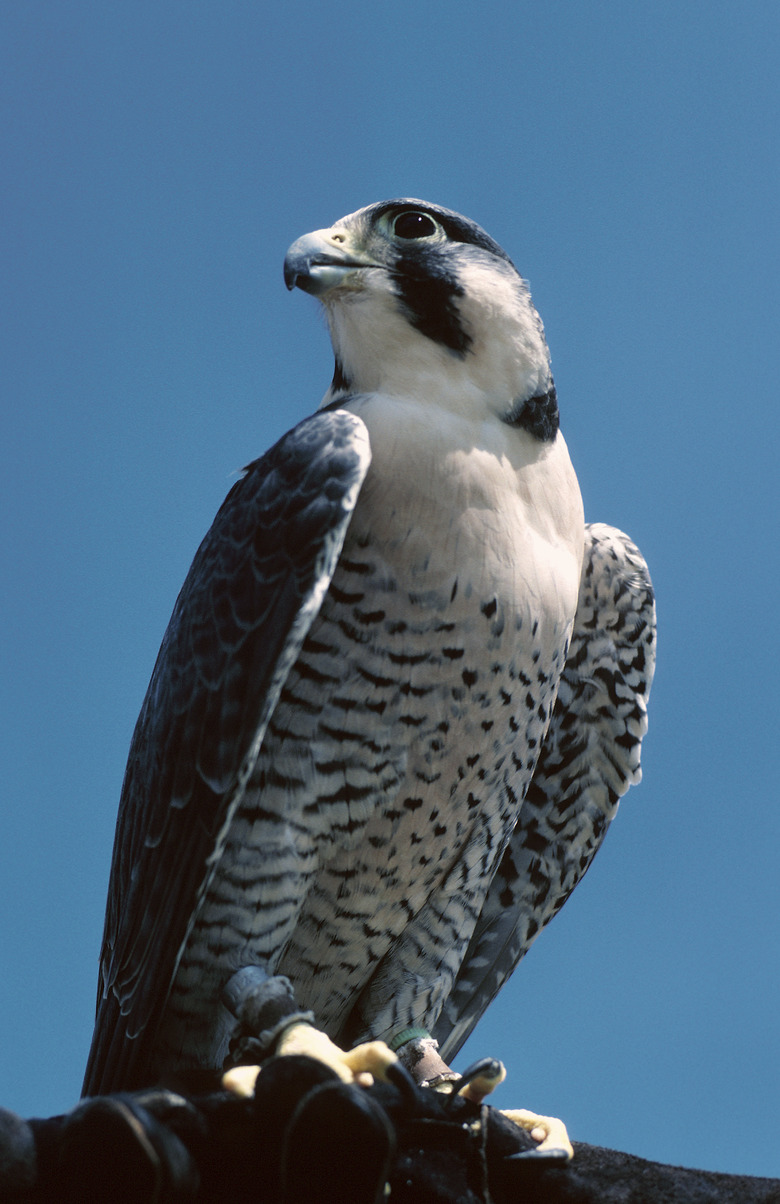The Characteristics Of Falcons
Falcons, hawks, eagles and even owls look pretty similar at a glance. All of these birds share the same sharp, curved beaks and have exceptional eyesight and wickedly pointed talons on their feet. However, upon closer inspection falcons have several unique characteristics and behaviors that separate them from the other birds of prey. Falcons differ from eagles and hawks in their hunting behavior, beak shape, body size, speed during flight and taxonomic classification.
Falcon Definition
Falcon Definition
Falcons are a group of predatory birds quite similar to hawks and eagles. A relatively wide family of birds, falcons differ from hawks and eagles genetically and taxonomically. Researchers define all members of the taxonomic family Falconidae as "falcons." From there, they divide the 64 different falcon species into two subfamilies.
The Polyborinae subfamily contains the forest-falcons and the caracaras. The Falconinae subfamily contains the falconets and "true" falcons. Though the different groups do vary slightly, they all share the same defining characteristics of falcons.
The Characteristics of Falcons
The Characteristics of Falcons
So what does a falcon look like, exactly? They certainly have a few physical characteristics that set them apart from other birds of prey, but their behavior also factors into the equation as well.
For example, falcons tend to fly significantly faster than hawks and eagles. Their speed, which they use while hunting in the air, is achievable through a slightly different body shape than other birds of prey. These birds typically have smaller bodies and longer wings than hawks and eagles do, helping them achieve swifter flight. Like most predatory birds, male falcons generally do not grow as large as female falcons do. Because most species have similar plumage color and pattern, size is the most observable factor when differentiating between male falcons and females.
You can find another defining characteristic of falcons in the shape of their beak. All members of the falcon family have a distinctive groove, known as a tomial tooth, which helps them swiftly and effectively dispatch their prey. That tooth comes into play while hunting, as falcons use their beak to kill their prey rather than their talons. Hawks prefer to squeeze their prey with their feet to subdue it, but falcons use the tooth on their beak to break the neck of their prey.
Falcons also tend to hunt flying prey, such as birds and bats, while in the air, while many hawks feed on ground-dwelling mammals like rats and mice, which you don't as frequently see a falcon prey upon. Their smaller body size and rapid flight make them the perfect on-the-wing predator, swiftly capturing small prey out of the air.
The Different Types of Falcons
The Different Types of Falcons
The various falcon breeds and species live everywhere but the polar regions. Though all of the various species bear the "falcon" classification, many carry different names. The falcon family contains falcons, forest-falcons, falconets, caracaras, kestrels and hobby falcons. The different groups differ slightly in appearance. For example, caracaras generally have longer legs and necks than other falcons, and many sport a brightly colored face.
The Fastest Bird on Earth
The Fastest Bird on Earth
While most falcons fly faster than hawks and eagles, none top the speed of the peregrine falcon. Researchers have recorded peregrine falcons reaching confirmed speeds of 180 mph during a stoop, or dive. However, scientists believe these birds can potentially reach upwards of 200 mph during stoops. This means that not only is the peregrine the fastest bird on the planet, but also the fastest animal on earth!
Threats to Falcons
Threats to Falcons
The peregrine falcon also provides the perfect model for threats to falcons and other birds of prey. This species faced a sharp population decline during the 1960s and 1970s due to the use of detrimental pesticides such as DDT. Small amounts of toxic pesticides accumulated in the birds' systems from eating prey that had been exposed to the pesticide. Over time this resulted in weakened eggshells, which caused poor reproductive rates and even mortality in adult birds.
Through the banning and intensive regulation of pesticides, as well as through conservation efforts, the populations of the peregrine falcon bounced back entirely, and the International Union for Conservation of Nature currently lists the species in their "least concern" category. However, the impact on this species provides a grim example of the potential impacts of pollution on falcons – and all predators at that. All animals at the top of the food chain, from eagles to killer whales, face a direct threat from bioaccumulation of toxins. However, the peregrine falcon shows us that regulation and conservation efforts can successfully reverse these impacts and save a species from extinction!
Cite This Article
MLA
Zinni, Yasmin. "The Characteristics Of Falcons" sciencing.com, https://www.sciencing.com/characteristics-falcons-10048987/. 30 September 2021.
APA
Zinni, Yasmin. (2021, September 30). The Characteristics Of Falcons. sciencing.com. Retrieved from https://www.sciencing.com/characteristics-falcons-10048987/
Chicago
Zinni, Yasmin. The Characteristics Of Falcons last modified March 24, 2022. https://www.sciencing.com/characteristics-falcons-10048987/
